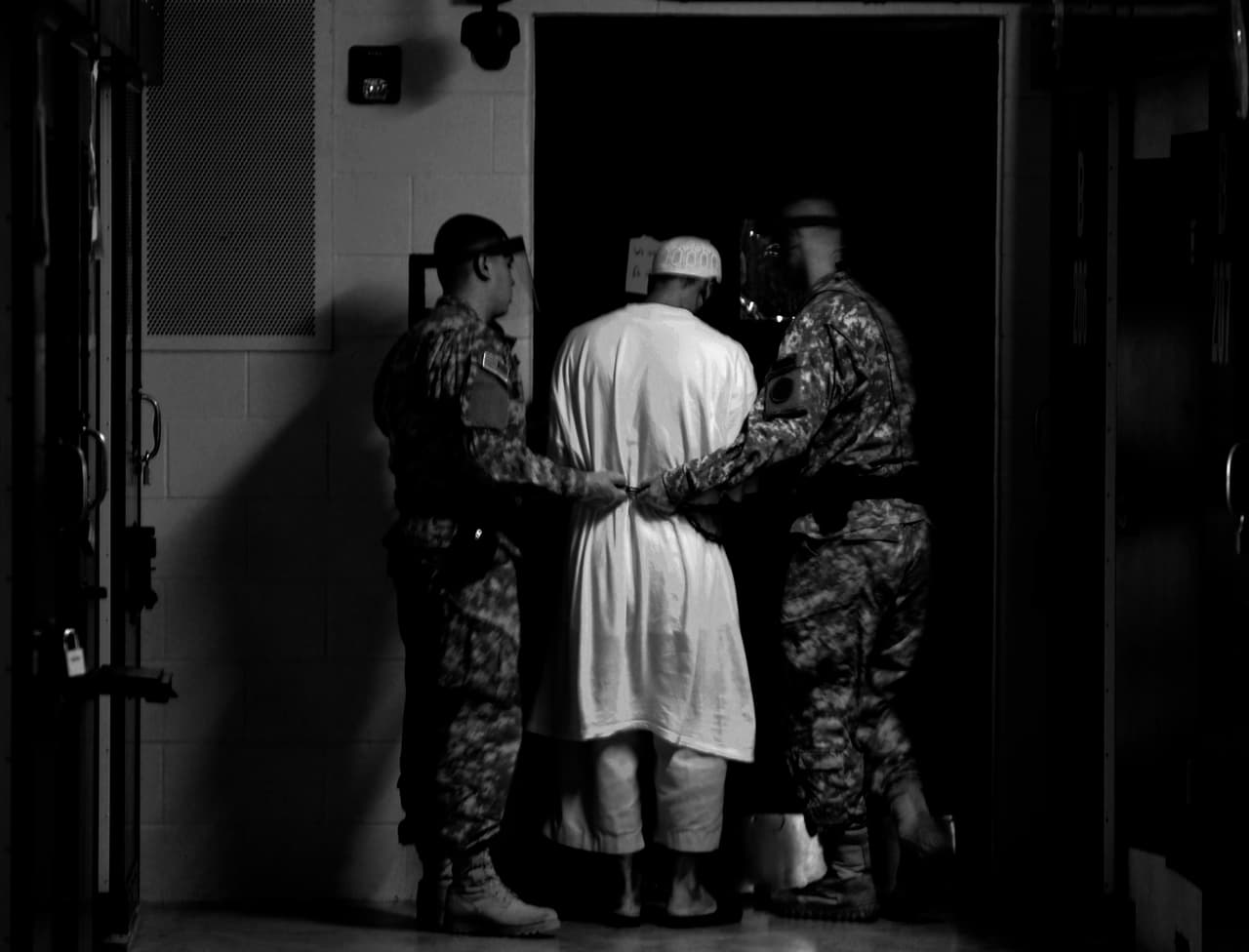
Revealed: Only 29 detainees from secret CIA torture program remain in Guantánamo Bay
Guards from Camp 5 at Joint Task Force Guantanamo escort a detainee from his cell via Flickr/DVIDSHUB
Less than a quarter of the 119 detainees named in the US Senate’s summary report into the CIA’s secret torture programme remain in the military prison for the most “hardline” terror suspects – Guantánamo Bay – the Bureau has established.
Milestone research by the Bureau and The Rendition Project has identified only 36 individuals who were sent to Guantánamo after their “interrogations” by the CIA – and of those, just 29 remain at the prison on the island of Cuba. One of them has been recommended for transfer.
One of the 29 still in custody is Majid Khan, who was described in the report as being subjected to tortures including the brutal procedure known as rectal feeding.
This research is being made possible with the help of Freedom of the Press Foundation.
If you think it is important please consider donating.
Seven of the 36 were released between March 2007 and January 2010 – of whom six were transferred abroad and one was sent to a maximum security jail in mainland USA.
There have been a number of releases from Guantánamo in recent months, including one last night when five detainees were sent to Oman and Estonia.
However, new research by the Bureau and The Rendition Project has found that the military prison camp contains few of the 119 individuals named in last month’s Senate Intelligence Committee’s report into the CIA’s secret detention and interrogation programme.
The Bureau’s new investigation has produced a database which begins to provide details of what happened to each of the 119 individuals.
The database is freely available here. [Note: At the time of publication, we made the data freely available. However as our investigation has progressed that data is now out of date. For the latest data please see our first quarterly report.]
It has established for the first time their dates of entry and exit into the programme and shows which of the prisoners were eventually transferred to the US military detention camp in Guantánamo Bay.
While 36 were originally transferred to Guantánamo, the rest were either released without charge, sent to other US military prisons in Iraq or Afghanistan, or turned over to foreign governments.
The Senate’s full report ran to 6,700 pages, but only a 499-page summary was published in December 2014 and within this, crucial details were redacted after objections from the White House — to the anger of committee chair Dianne Feinstein.
The summary named 119 of the CIA’s prisoners put through the programme from 2002 until 2008, but it offered no full analysis of their time in custody. It instead gave a few individual case studies.
The Bureau has produced a comprehensive timeline for the 119 detainees by correlating new information in the Senate report with previously published investigations, legal filings, flight data and other material, including unpublished documents on file with the international NGO Reprieve.
Although the rough outlines of the CIA’s detention programme have long been established by legal teams and investigators, the Bureau’s analysis of the Senate report confirms and clarifies many details and offers many threads for further research.
The research casts new light on the programme’s evolution and eventual dismantlement. It shows, for example, that there were 28 people left in the programme in 2006, the year it was effectively dismantled.
The research also opens fresh possibilities for accountability and legal redress, according to lawyers who have worked on some of these cases.
Three senior lawyers representing a number of former CIA detainees welcomed the Bureau’s findings.
Meg Satterthwaite, Director of the Global Justice Clinic at New York University School of Law, said: “This project to restore information blacked out in the Senate report reveals important data about former detainees’ time in the CIA’s detention system.
In 54 of these, the Bureau has established entry dates into the programme to an accuracy of 10 days or fewer. Of these, the majority (32) are accurate to 5 days or fewer.
In all but 29 cases, the Bureau has established an entry date within a 30-day range.
“This kind of careful analysis is crucially important for those working to understand the US extraordinary rendition and torture program. For years, we have tried to create tables like the one included here, but essential information was always missing.
“This table will allow lawyers representing former detainees, human rights investigators, and citizens seeking the truth about what was done in their name to move several elusive pieces of the puzzle into place concerning the fate and whereabouts of the disappeared.”
Steven Watt, senior staff attorney at the American Civil Liberties Union, said: “This research, confirming the dates and duration of the men’s confinement is important not just for transparency purposes but also for the men themselves.”
And Cori Crider, strategic director of the Abuses in Counter-Terrorism Team at Reprieve, added: “Even after publication of the CIA Torture Report, we’re none the wiser about the fates of dozens of men the US disappeared.
“Tracing them and their precise dates in custody does not just honour the dispersed and the dead, it is a crucial part of building a record that, one day hence, may be the cornerstone on which accountability is built.”
In a few cases, our analysis indicates inconsistencies in the detainee chart published in the Senate summary report. Sharif el-Masri entered the CIA programme between September 10 and 30 2004, as a transfer from a foreign government. The report states that he was sent back to the same government approximately three months later. The chart, however, records that the CIA held him for over 800 days. Likewise, Hambali – captured alongside Bashir bin Lap in Thailand on August 11 2003 – was included among the 14 prisoners transferred to Guantánamo Bay in 2006, effectively the last year of the programme, whereas the chart has him remaining in CIA custody until February 2007. Janat Gul, who entered CIA custody in July 2004, must also have been transferred out of the programme by September 2006. Inconsistencies in Senate Committee report
*This report is part of a joint investigation with The Rendition Project and is being supported by the Freedom of the Press Foundation.
*To support the Freedom of the Press Foundation’s fundraising appeal for this investigation, click here.
Follow Crofton Black on Twitter. Sign up for email updates from the Bureau here.
This report was amended on January 15 to include an additional detainee from the CIA interrogation programme who was subsequently identified as remaining in Guantanamo.



